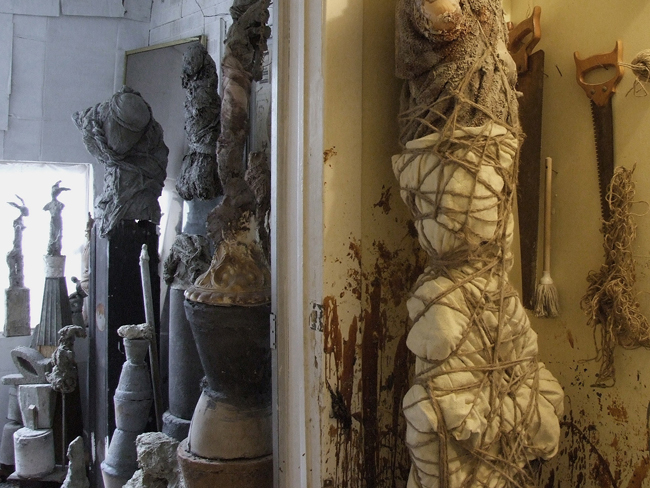“I was raised in a family of nine, five of whom lived through World War II, and two through World War I as well. Growing up, the world around me felt seeped in the emotions of regret and guilt, fear and anxiety, anger and helplessness. Looking back, I would say that even as the war became history, people somehow remained at war in their minds. It was part of family-life and embedded in the collective mindset–everyone seemed busy destroying the other. I didn't know anything different. My fictitious character, Joseph Wagenbach, shares some of this history with me. He immigrated to Canada the year I was born, and, like me, thought he could leave his past behind. But it was not possible. However, we found ways to escape by creating alternative worlds.” Iris Häussler
The liminal worlds conjured by Häussler imagination seem to exist in a space that is both, or perhaps neither, here nor there: familiar and uncanny; past and present; fact and fiction; sculpture and theatre. There is a sense of voyeurism, or maybe trespassing, as she permits visitors into the private physical and psychological realms of another. The artist’s process is often deeply immersive and laborious, giving over to her characters’ mindsets and habits completely. In a small existing house in downtown Toronto, she embodied, materialized, and performed “The Legacy of Joseph Wagenbach.”
In 1962, Joseph Wagenbach immigrated to Canada and set up a studio in a small unassuming house in downtown Toronto. For decades Joseph worked reclusively, unnoticed by his neighbours, obsessively making sculptures of every size, incorporating unconventional techniques and materials. The sculptures he created were haunting and visually peculiar – formed by memories of World War II, stories of immigration, unsettled and displaced identity, and fantasy fiction. Following Joseph’s death from a stroke, the ‘discovery’ of his studio and the alternative world he left behind, invited much curiosity and speculation. The little house was filled with sculptures arranged on every surface, some elevated on makeshift plinths. The atmosphere was museological, the sculptures standing as both art and artefact.
In the summer of 2006, the house that held “The Legacy of Joseph Wagenbach” was (factiously) designated an assessment site by the Municipal Archives* and quietly opened to the public for viewing. Häussler trained ‘archivists’ to lead visitors on tours of Wagenbach’s found studio. At first, no one came. But soon, word-of-mouth would bring more than 1500 visitors. Some visitors to the studio/archive/museum/exhibition were so taken in by the unsettling detail with which the artist had realized her character’s life and legacy, complained that they felt deceived...
*The Municipal Archives were a fictional institution created by Iris Häussler for mediating her project to the public.


